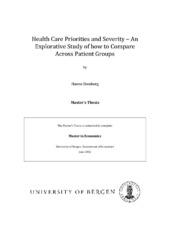Health Care Priorities and Severity - An Explorative Study of how to Compare Across Patient Groups
Master thesis
Permanent lenke
https://hdl.handle.net/1956/6140Utgivelsesdato
2012-06-01Metadata
Vis full innførselSamlinger
- Department of Economics [301]
Sammendrag
This thesis looks at health care priorities across patient groups, and compares two interventions for two different patient groups with base in the defined Norwegian priority criteria of severity, effect and cost-effectiveness. The comparison takes base in existing studies, and a methodological “gold standard” is defined to enable a comparison across the groups of heroin abuse and metastatic colorectal cancer. The aim of the thesis is to illustrate how an operationalization of severity can affect priority decisions, and the severity measure of absolute QALY loss (AQL) is compared to the severity measure of relative QALY loss (RQL). The methadone intervention for heroin abuse proved to be both more effective and more cost-effective than the cancer intervention of bevacizumab, both when considering a societal and a provider perspective. The two severity measures provided opposing results. With AQL, heroin abuse was almost twice as severe as cancer with a loss of 41 QALYs compared 23 QALYs. RQL resulted in a ratio of 0.66 for heroin abuse and 0.96 for cancer, which indicates the opposite conclusion. The main results rests on undiscounted QALYs. When discounting the QALYs, AQL becomes almost equal for the compared groups, mainly due to the age difference. Since the severity measures are based on the patients’ qualityadjusted life expectancy (QALE), a possible gender effect is relevant because women on the average live longer than men. The use of a fixed innings threshold is also depicted as an alternative to QALE. A final choice of severity measure was difficult to make, but some arguments are provided in favour of AQL as this measure has some inbuilt elements that have the ability to reduce a possible ageism critique. In addition, the argument is made that age actually does matter.
